There are more than 100 different types of grunt fish. So, if you are saltwater fishing for the first time, you’ll most likely have a hard time properly identifying each one. Each fish has different regulations too.
Before you pay an expensive fine, here is our complete guide to the most common types of grunt you’ll come across during your fishing trips.
Fish Profile: Grunt Fish Overview
Grunt fish have a unique shape that makes them appear front-heavy due to their ability to make grunting noises. They do so by grinding their teeth to produce the sound. Their bodies are laterally compressed, helping them easily swim through tight spaces.
There are many subspecies of grunt fish that include White grunt fish, Blue-striped, French, Key west grunt, Yellow grunt fish, and more. Some have blue stripes, while others have, yellow, silver, and copper scales. Their colorful scales transition to white on the underbelly.
This carnivorous fish stalks seagrass beds during the night foraging for their prey. The grunt fish diet consists of crustaceans, occasional small fish, and bivalves.
During the day, they find refuge around coral reefs as protection against predators. You can find them around structures like docks, coral reefs, and mangroves in brackish water.
Types of Grunt Fish
There might be 150 different types of grunt fish, but fishermen target only a few – either for bait or fishkeeping. Here are the most common types of grunt fish you’ll find in the ocean. Some of them are safe to eat, while others are poisonous.
White Grunt
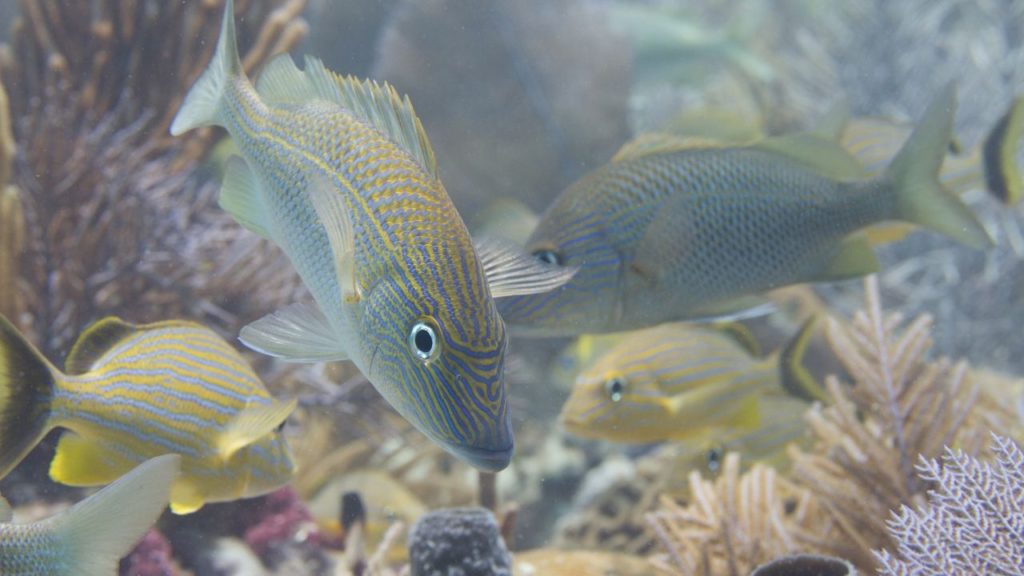
| Scientific Name | Haemulon plumierii |
| Other Names | Common grunt, redmouth |
| Family | Haemulidae |
| Appearance | Silver-gray body with blue and yellow stripes on head and body |
| Ave. weight & length | Most are 1.5 pounds and 15 inches in length |
| Habitat | Shoreline to reef edges, any irregular bottoms from depths of 80 to 115 feet. Juvenile white grunts are common in seagrass beds. |
| Range | Virginia to Brazil, including the Gulf of Mexico, Caribbean, and Bermuda |
| Game Quality | Really Good |
| Conservation Status | Least concern |
The White grunt fish is an underappreciated and overlooked species when it comes to sport fishing, and consumption. Their meat is of good quality and can be found fresh in markets. It is also a key part of a historic Floridian dish “Grits and Grunts.”
Anglers don’t normally target them but are unintentionally caught when targeting other species such as snappers, groupers, and triggerfish. They’re not the largest fish in the sea or brackish-water at an average of 15 inches in length and 1.5 pounds.
However, it is not unheard-of catching ones of unusually large sizes from 4 to 6 pounds. They are fun to catch, and charter boats will use manual or electric reels over the outer reef edge to catch white grunts.
This species has earned the nickname redmouth and ruby red lips from the vibrant red coloring on the inside of its mouth. The White grunt is named such for its silvery sides and its ability to make grunting sounds by grinding its teeth.
If you are curious about the taste of a White grunt, its white, flaky flesh has a mild flavor, which some say is like black bass.
Blue-Striped Grunt
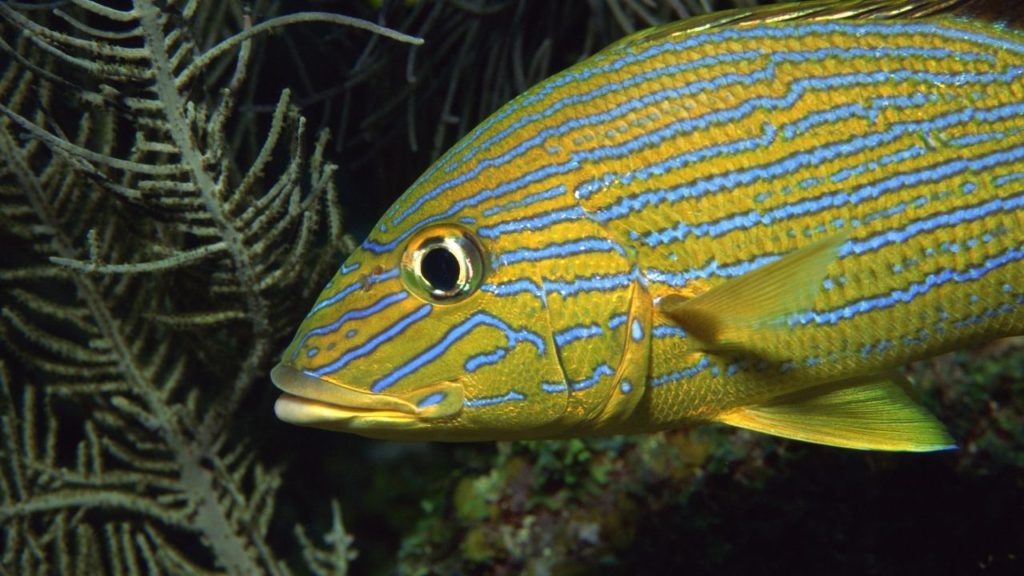
| Scientific Name | Haemulon sciurus |
| Other Names | Boar grunt, golden grunt, humpback grunt |
| Family | Haemulidae |
| Appearance | Bright blue stripes from head to tail, yellow body |
| Ave. weight & length | 10 to 14 inches and 1.7 pounds |
| Habitat | Mangroves, reefs, and coral and rocky substrates at depths to 98 feet. |
| Range | South Carolina to Brazil, Gulf of Mexico, Bermuda, and the Caribbean |
| Game Quality | Good |
| Conservation Status | Least concern |
The Blue-Striped Grunt fish is a beautifully colored fish with its golden yellow body and bright blue stripes. They sport the same bright red mouth as the French and White grunt as well. It is because of this that this species is fished primarily for aquarium usage.
They are not a typical sportfish and are only sought for fish tank purposes or being sold fresh in markets for consumption.
They stay on the smaller side for size with their maximum length being 18 inches. These grunts are carnivores and will feed on smaller prey, including invertebrates, shrimp, small fish, and bivalves in areas of seagrass and mangrove habitats.
Expert Tip: Grunt fish are sensitive to line, so using a lead weight to carry your bait all the way to the bottom is ideal for getting them to bite. Keep in mind that you should let the line move freely through the weight.
French Grunt

| Scientific Name | Haemulon flavolineatum |
| Other Names | Banana grunt, gold laced grunt, open-mouthed grunt |
| Family | Haemulidae |
| Appearance | White to blueish or yellow with vibrant yellow to orange stripes |
| Ave. weight & length | 0.5 to 1 pound, and 6 to 8 inches |
| Habitat | Coral reefs, ledges, seagrass beds in bays and lagoons. Found in shallow waters to depths of 197 feet |
| Range | South Carolina, Northern Gulf of Mexico, Brazil, Bermuda, Central America to West Indies |
| Game Quality | Excellent |
| Conservation Status | Not yet evaluated |
When it comes to catching saltwater panfish, the French grunt fish is highly popular because of their small size and bright bronze or yellow and blue color.
Like other grunt fish, they’re active at night when feeding and school together during the day. French grunts also typically feed on clams, krill, shrimp, and small hermit crabs, which is good to keep in mind because using their natural prey as bait will give you the most success at catching them.
Expert Tip: When fishing for French grunts, use their natural prey as baits. You should also opt for an extra-light tackle as they are sensitive to the line and small.
They are also good to eat and can be found fresh in markets, but they are also extremely popular in aquariums and saltwater fish tanks.
Pigfish
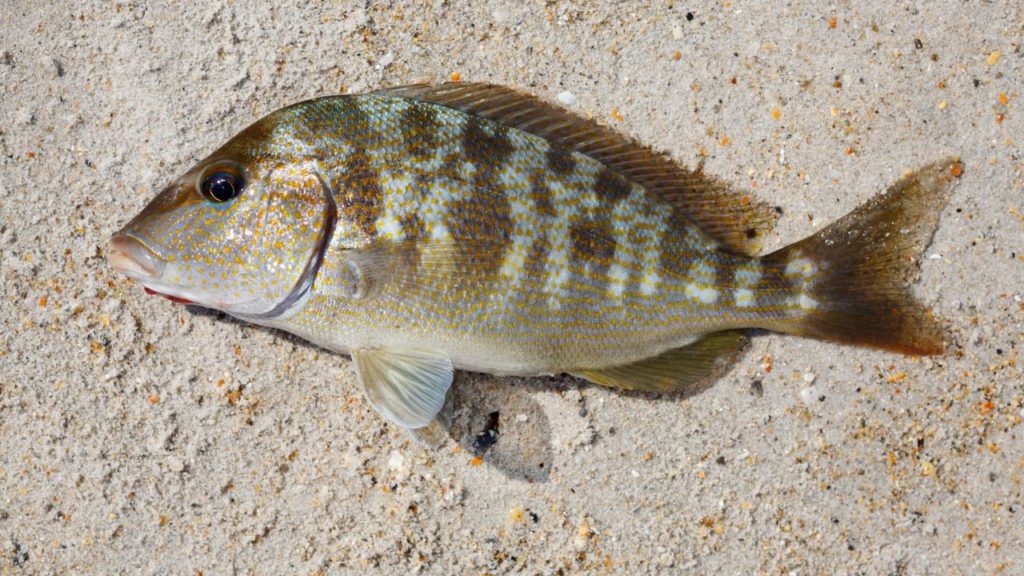
| Scientific Name | Orthopristis chrysoptera |
| Other Names | Piggy perch, piggy, grunt |
| Family | Haemulidae |
| Appearance | Mottled brown or gray body with irregular vertical bars and small orange or blue markings |
| Ave. weight & length | 2 pounds and 6 to 12 inches |
| Habitat | Shallow coastal waters with sand or mud bottoms, grassy beds and edges of channels |
| Range | As far north as Cape Cod, most common south of Chesapeake Bay |
| Game Quality | Excellent |
| Conservation Status | Least concern |
The Pigfish are in the same family as other grunt fish, but they look a little different. They’re called pigfish because they squeal like a pig when you catch them.
They come in at a smaller size on average between 6 and 12 inches, but they can get up to lengths of 19 inches and weigh from 1 to 5 pounds.
Expert tip: You can use Pigfish as baitfish to catch larger fish.
Much like grunts in their family, you can find Pigfish around structures like seagrass beds, docks, piers, and drop-offs. It is best to use a two-hook bottom rig with peeled shrimp or bloodworms to catch them. However, you can also catch them using plugs or small jigs too.
Black Margate

| Scientific Name | Anisotremus surinamensis |
| Other Names | Piggy perch, piggy, grunt |
| Family | Haemulidae |
| Appearance | Silvery sides with black tipped scales, and black fins and tail |
| Ave. weight & length | 12 to 17 inches and 3 to 8 pounds |
| Habitat | Steep sloping bottoms, rocky substrates or rocky reefs at depths to 65 feet |
| Range | Florida, Gulf of Mexico, Brazil, Bahamas, and Caribbean |
| Game Quality | Very good |
| Conservation Status | Not yet evaluated |
Anglers commonly target the Black Margate during the spawning season in spring. The best way to catch them is drift fishing using baits like fish, squid, or cut clams. This method is effective because they will gather in shallower water and in large schools than where they are usually found, which is 65 ft down steep sloping bottoms.
This species is one of the largest fish in the grunt fish family – it reaches up to 30 inches in length and 13 pounds. This makes them a lot of fun to catch, and you have enough meat to make fillets!
Tomtate
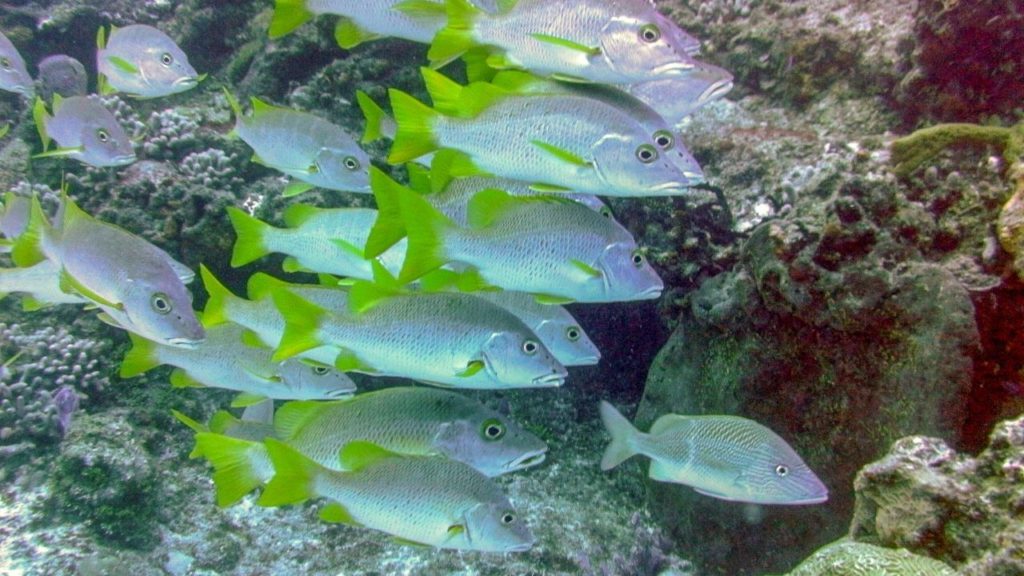
| Scientific Name | Haemulon aurolineatum |
| Other Names | Brown grunt |
| Family | Haemulidae |
| Appearance | Gray to tan back, brown or yellowish stripe from head to tail, bright orange mouth, dark spot at base of tail |
| Ave. weight & length | 1 pound and get 5.5 to 10 inches |
| Habitat | Coral and rock reefs at depths of 100 feet |
| Range | North Carolina to Gulf of Mexico, Caribbean, and Brazil |
| Game Quality | Good |
| Conservation Status | Least concern |
Tomtate are the smallest of the grunt fish family, making them excellent panfish for anglers to catch and use as bait. You’ll want to use light tackle and small hooks baited with cut shrimp, squid, or fish.
Tomtate is oftentimes confused with blue-striped, white, and French juvenile grunt fish. All of which eventually lose the dark spot marking at the base of the tail, while the tomtate does not. They also feature the same bright red coloring inside of the mouth and previously listed grunts as well.
They function as great indicators of larger predatory fish being nearby as they scatter in their presence
Porkfish
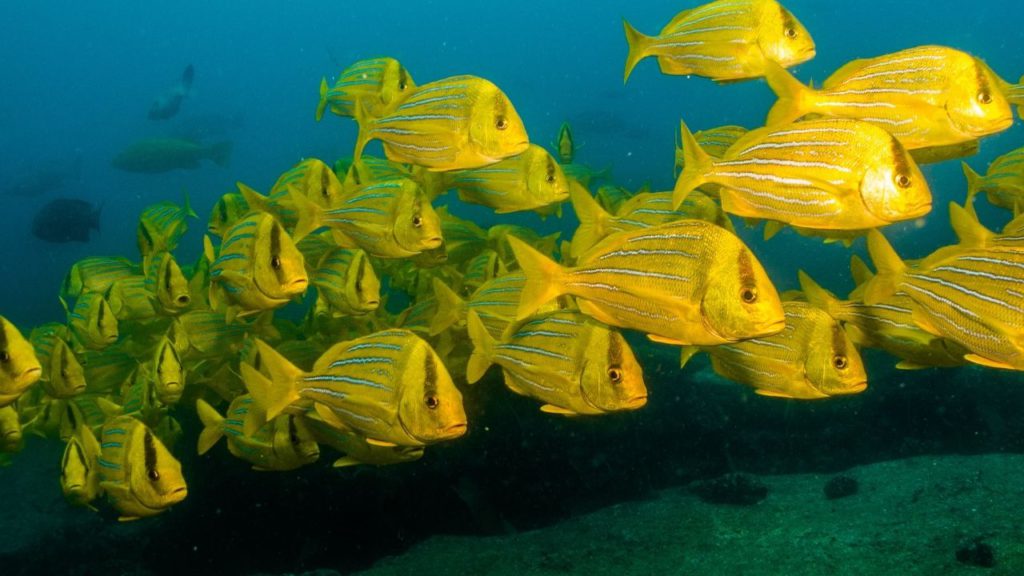
| Scientific Name | Anisotremus virginicus |
| Other Names | Paragrate grunt, Atlantic porkfish |
| Family | Haemulidae |
| Appearance | Dark bar from top of head to mouth, yellow and silver stripes, bright yellow fins |
| Ave. weight & length | 4 ounces to 2 pounds and 6 to 15 inches |
| Habitat | Reefs and rocky bottoms at depths of 6 to 65 feet |
| Range | Florida to Brazil, Gulf of Mexico, and the Caribbean to Bahamas, and Bermuda |
| Game Quality | Very good |
| Conservation Status | Not listed as endangered or vulnerable |
Porkfish are another species that is common in aquariums and fish tanks, but they are also popular sportfish as well. If you want to catch Porkfish, you should use a light tackle, natural baits like shrimp or worms and jigging.
Expert Tip: If you are fishing for White grunt fish, don’t be surprised to reel in Porkfish too! These two types of grunt often swim together.
Similar to all other grunts, they are active at night, preying on crustaceans, worms, and mollusks. They also travel in large schools during the day to protect themselves from predation.
Alert: They are nt ideal for eating as they have been linked to ciguatera poisoning that causes nausea, vomiting, abdominal pain, and more. They are better for catching and releasing or observing while on diving excursions.
Grunt Fish FAQs
Is a Grunt Fish a Snapper?
Grunt fish are similar to and often mistaken for snappers and vice versa, but they are separate species. Grunts lack the canine teeth that snappers are known for. They are also much smaller and feature a deeper notch in their tail fin. Besides grunt fish also make the sound they’re named after while snappers do not.
Why Are Grunts Called Grunt Fish?
Grunts are called such because all species make a sound much like grunting. They do this by grinding their pharyngeal teeth together. The sound is actually amplified because their swim bladder is kept taut. Pigfish make a very similar sound which makes it easy for people to confuse the two.
Is Grunt Fish Good to Eat?
Most grunt fish are good to eat and are sold in markets. In fact, white grunt fish are used in a historic Floridian meal called “grits and grunts.” Even though many are good to eat, it is important to do your research because there are toxic species in the grunt fish family.
It’s a Wrap, Grunts!
Properly identifying the species, you are fishing for is the most important thing for an angler to do. There are different regulations and restrictions on each one, especially if you are catching them to eat. The guide we’ve provided above should help you to have a better understanding and knowledge of some of the most popular grunts.
Table of Contents



